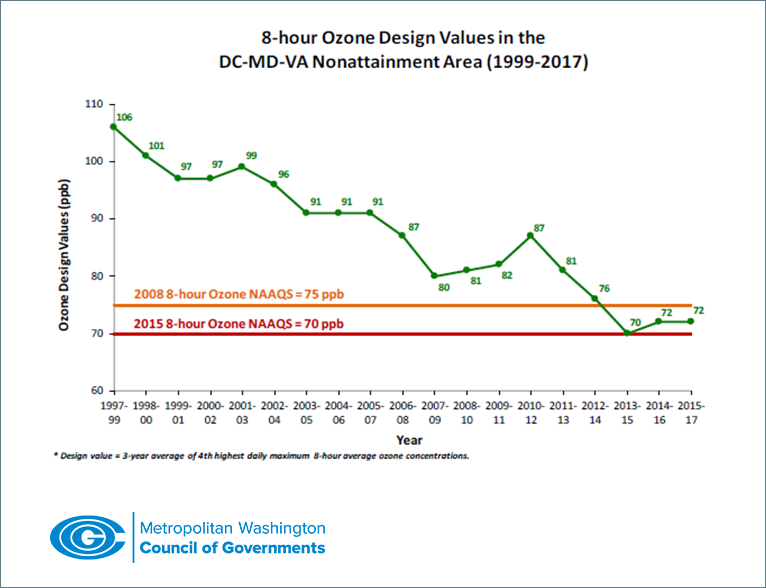Air quality continues to improve in metropolitan Washington, according to ozone-season data released today by the Metropolitan Washington Council of Governments (COG).
The region recorded just eight days in 2017 when air quality exceeded levels for ground-level ozone that are unhealthy for sensitive groups—also known as ‘Code Orange’ days. In 1998, there would have been ten times as many unhealthy air days if using today’s 2015 Ozone Standard. None of this year’s exceedance days reached more serious ‘Code Red’ unhealthy levels, despite 24 90-degree days in the region.
“We’ve seen a dramatic improvement in the region’s air quality thanks to more than a decade of action and coordination at all levels of government,” said Hans Riemer, Metropolitan Washington Air Quality Committee (MWAQC) Chairman and Montgomery County Council Member. “Still, area residents continue to breathe unhealthy air too often. We must work together to continue to reduce emissions that contribute to ground-level ozone.”
Ground-level ozone is a colorless gas created when air pollutants react on hot, sunny summer days. Sensitive groups such as people with lung disease (including asthma, emphysema, and chronic bronchitis), children and older adults, and people who are active outdoors may experience adverse health effects when air pollution levels are elevated for a prolonged period of time.
In addition to the 2017 data, COG released a new report, Improving the Region’s Air, that tracks all six air pollutants regulated by the Clean Air Act—ground level ozone, particulate matter, carbon monoxide, sulfur dioxide, nitrogen dioxide, and lead—and shows downward trends in the region over the last 12 years.
The region meets federal health-based air quality standards for all but one pollutant—ground level ozone. In 2015, the EPA revised the standards for ground-level ozone to achieve levels that were more protective of public health; current data shows that the region is just above that standard of 70 parts per billion (ppb).

*2017 data is incomplete, and preliminary as of September 22.
The Metropolitan Washington Air Quality Committee, which is staffed by COG, coordinates air quality planning in the region. Its members include area elected officials, environmental directors, and state air management and transportation officials.
MORE:
Improving the Region’s Air: Air Quality Trends for Metropolitan Washington
Ozone Season Summary Presentation
What code red days? Washington achieves best air quality in decades. (Washington Post)